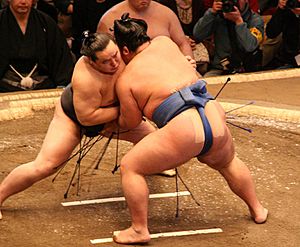Sumo facts for kids

A sumo match (tori-kumi) between yokozuna Asashōryū (left) and komusubi Kotoshōgiku in January 2008.
|
|
| Focus | Grappling |
|---|---|
| Hardness | Full contact |
| Country of origin | Japan |
| Olympic sport | No, but IOC recognized |
Sumo (相撲, sumō) is a Japanese full-contact sport.
In sumo, a wrestler (rikishi) attempts to force another wrestler out of a circular ring (dohyō) 4.55 metres in diameter. Also, the rikishi try to use their skill to force an opponent to touch the ground with anything other than the soles of his feet.
Sumo tournaments take place in Tokyo, Osaka, Nagoya and Fukuoka.
Sumotori
Sumo wrestlers (sumotori) are ranked into a hierarchy based on win-loss statistics in competitive tournaments.
Grand champions
Those who have earned the highest rank are grand champions (yokuzuna).
- Akashi, 16th century
- Maruyama, (1712-1749)
- Tanikaze (Kajinosuke, 1750-1795)
- Onagawa (1758-1805)
- Ao no Matsu (1791-1851)
- ...
- Chiyonofuji Mitsugu (b. 1955)
- Takanosato (b. 1952)
- Futahaguro Koji (b. 1963)
- Hokuto-umi, (b. 1963)
- Onokuni (b. 1962)
- Asahifuji (b. 1960)
- Akebono (b. 1970)
Foreign-born competitors
Sumo has changed in modern times. Foreign-born wrestlers are part of the sport. For example, Konishiki and Akebono are Hawaiian-born athletes who earned places for themselves.
In 2008, Kotooshu from Bulgaria won a championship. In that same year, two top wrestlers, Asashoryu and Hakuho, were Mongolian. Hakuho won the Nagoya tournament with no losses, 15-0.
Images for kids
-
Sumo wrestlers at the Grand Tournament in Osaka, March 2006
-
Bulgarian amateurs – on the right is the national coach Hristo Hristov
See also
 In Spanish: Sumo para niños
In Spanish: Sumo para niños








